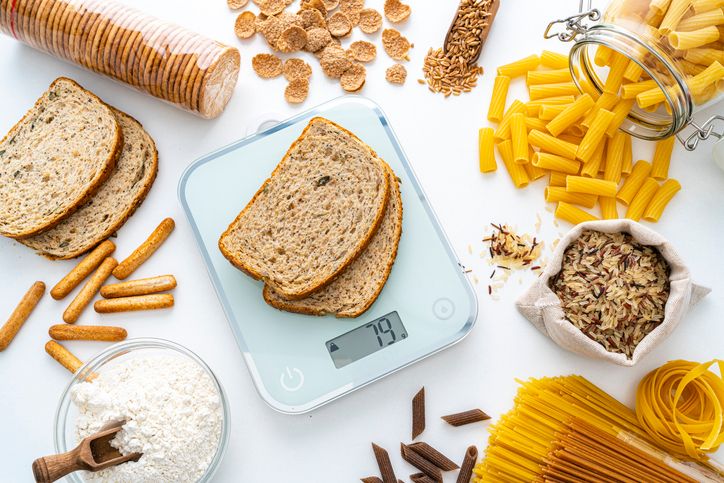
Author: Natalie Ng|Updated: 20 June 2025
In the beginning, weight loss usually feels easy. You cut back on food, stay active, and the scale moves. Then, at some point, it stops—even though you're still trying. This pause in progress is known as a weight loss plateau, and it's a common part of the process. Your body adjusts as you lose weight. With less body mass, you burn fewer calories. Your metabolism may slow down, and your usual routine might not have the same effect it once did. Sleep, stress, and daily movement can also change over time, affecting how your body responds. Even small shifts in how much you eat or how often you move can quietly influence your progress. Hitting a plateau doesn’t mean something is going wrong. It just means it’s time to make a few smart changes. Keep reading to learn what causes a weight loss plateau and how to get the scale moving again.

Weight Loss Plateau Reason 1 : Your Body Has Adapted to Your Current Calorie Intake

Lower Body Weight Reduces Calorie Burning
As your weight drops, your body naturally uses less energy. This is one of the most common reasons behind a weight loss plateau. Your total daily energy expenditure decreases, and the number of calories you burn no longer matches the intake that worked at the start of your weight loss journey. This shift happens gradually, especially if you've lost a significant amount of body weight.
Your metabolism hasn’t shut down or become damaged. Instead, your energy balance has changed. Your resting energy expenditure drops, and if you've lost muscle mass or your physical activity level has decreased, the body ends up burning fewer calories each day. Without adjusting your energy intake, fat loss slows down or stops.
Recalculate Intake Based on Current Weight
To maintain weight loss and continue progressing, it helps to recalculate your calorie needs after every 10 to 15 pounds of weight reduction. As your body weight decreases, so does your calorie requirement—even if your routine stays the same.
Track Intake and Watch for Hidden Calories
A useful step is to track your food intake carefully for one full week. Many people unintentionally:
• Serve slightly larger portions
• Add more oil, sauces, or condiments than expected
• Snack more often without noticing
These small habits increase overall energy intake and can be enough to cancel out your caloric deficit. If you've stopped losing weight, reducing your intake by 100 to 200 calories may help restart fat loss without needing a major diet change.

Weight Loss Plateau Reason 2 :You're Not Measuring Food Portions Correctly

Misjudging Portions Affects Caloric Intake
Even with the best intentions, most people misjudge how much they're eating. Studies show that food intake is often underestimated by 20 to 50 percent. When you're trying to maintain a caloric deficit, those extra, unnoticed calories can cause your weight loss efforts to stall. It’s easy to think a spoonful of peanut butter or a small handful of almonds won’t matter, but over time, those added calories influence fat loss and energy balance more than expected.
Visual estimates rarely match the actual serving size. That "one tablespoon" might be closer to two. A cereal bowl filled “just halfway” may still be double the recommended amount. These unnoticed increases in food intake raise your total calorie consumption and can be enough to block further fat burning effects.
Tools That Help Improve Accuracy
To fix a weight loss plateau caused by portion inaccuracies, start measuring your food precisely for at least one to two weeks:
• Use a digital food scale to weigh proteins and carb-heavy foods
• Measure oils with a spoon instead of pouring freely
• Use measuring cups for dry items like rice, oats, and cereal
• Log every ingredient in a food diary or tracker—this includes snacks and condiments
You might discover that meals you thought were under control are providing more calories than your body weight currently needs.
Read More
Book Now to Experience
S6 Body Sculpting Treatment
1 Minute Self-Registration
Date should not be before minimal date

Weight Loss Plateau Reason 3 : Stress and Poor Sleep Are Slowing Progress
Hormonal Shifts Disrupt Your Weight Loss Efforts
Stress and lack of sleep often show up together, and both can interfere with your ability to lose fat. When you're under stress, your body produces more cortisol—a hormone that can increase belly fat storage and trigger food cravings, especially for high-calorie snacks. If you’re also not sleeping well, hunger hormones like ghrelin and leptin become unbalanced, which can lead to stronger food cravings and poor food choices.
This combination doesn’t directly stop fat loss, but it does affect the behaviors that drive weight loss. You might eat more, move less, or make quick food decisions that increase your energy intake without realizing it. Over time, these changes in behavior contribute to a weight loss stall.
High Cortisol Doesn’t Block Weight Loss on Its Own
Despite common claims, elevated cortisol from regular stress or poor sleep doesn’t shut down your metabolism. Most research shows that everyday stress levels don’t create major changes in your body’s ability to burn calories or lose fat. The real issue is how stress influences your habits.
Rather than worrying about cortisol levels, focus on actions you can control. Stick with regular physical activity, track your calorie intake, and follow your weight loss plan. Your body isn’t working against you—it just needs steady habits to keep moving forward.
Poor Sleep Encourages Comfort Eating, Not Fat Storage
Sleep loss doesn’t cause weight gain by itself, but it does increase the likelihood of emotional eating and late-night snacking. When you're tired, your body craves fast energy, often in the form of sugary or fatty foods. If sleep issues continue, this cycle can raise your total daily energy intake and lead to weight gain or a stalled weight loss journey.
You don’t need perfect sleep to lose weight. Focus on what you can improve. Go to bed at a regular time, reduce screen use before sleep, and keep your bedroom cool and quiet. These changes support better rest and reduce the chances of slipping into habits that delay weight reduction.
Stress Triggers Emotional Eating
Stress can also shift your relationship with food. You might find yourself reaching for snacks out of habit rather than hunger. These moments often happen:
• While rushing to meet deadlines
• After difficult conversations or emotional pressure
• During long evenings spent overthinking or worrying
• When you're mentally exhausted and want quick relief
By noticing these patterns, you can avoid emotional eating by shifting your focus, such as going for a short walk, writing in a journal, or even stepping away from your screen.

Weight Loss Plateau Reason 4 : Your Workout Routine Isn’t Challenging Your Body Anymore
Lack of Progress Signals Exercise Adaptation
Repeating the same workout for weeks or months without change can lead to stalled fat loss. Over time, your body becomes more efficient at the exercises you're doing. This means it burns fewer calories to complete the same routine. If you haven’t made any changes to your exercise habits, your weight loss plateau may be linked to this adaptation.
Muscle groups that aren’t being challenged stop developing, and your body composition stays the same. You might still feel like you’re working hard, but if there’s no new stimulus, your body weight may not change. This doesn’t mean your routine is wrong—it just needs adjustments to reignite calorie burning and support further fat loss.
Signs Your Routine Needs a Refresh
You might notice:
• You no longer feel as tired after workouts
• You’ve stopped seeing strength or endurance improvements
• Your motivation to exercise is dropping
• Workouts feel repetitive, but not more effective
• You’re not seeing changes in body composition
These signs suggest your body has adapted, and it's time to increase intensity or variety.
How to Add New Challenges Without Changing Everything
You don’t need a full workout overhaul. Small, targeted changes are often enough:
• Increase weights, reps, or sets gradually (progressive overload)
• Change your rest time between sets
• Add time or intensity to your cardio
• Rotate the order of exercises to target different muscle groups
These changes push your body to burn more calories and build more muscle, which helps restart fat loss and improve physical health.
Book Now to Experience
S6 Body Sculpting Treatment
1 Minute Self-Registration
Date should not be before minimal date

Weight Loss Plateau Reason 5 : You've Lost Muscle During Weight Loss
Lower Muscle Mass Reduces Calorie Burning
When muscle is lost during a weight loss program, your body’s ability to burn calories drops. Muscle tissue is more metabolically active than fat, so having less muscle means fewer calories burned at rest. This reduction in resting energy expenditure affects your total daily energy burn, making fat loss more difficult over time.
Even if fat loss continues, reduced muscle mass can cause a weight loss stall by shifting your calorie needs. If caloric intake stays the same while calorie burning decreases, the energy balance narrows or disappears completely. This often leads to a plateau, even when following the same routine.
Signs That Suggest Muscle Loss
• Basic exercises feel harder than before
• Strength levels have noticeably dropped
• Clothes fit differently in areas like the arms or thighs
• The body feels softer even without weight gain
• Recovery between workouts takes longer than usual
These signals may indicate that muscle mass has gone down during your weight loss journey, especially if resistance training and protein intake haven’t been a priority.
Key Habits That Preserve Muscle
To avoid losing muscle while continuing to lose fat:
• Include 0.8 to 1 gram of protein per pound of body weight daily
• Add resistance training to your weekly exercise routine at least three times
• Avoid extreme calorie deficits that make muscle preservation harder
• Allow enough sleep and recovery to support muscle repair
Keeping muscle mass intact helps maintain weight loss progress and supports long-term weight management. It also improves body composition and keeps your metabolic rate higher, helping your body burn calories more efficiently throughout the day.

Weight Loss Plateau Reason 6 : Hidden Calories Are Sneaking Into Your Diet
Unnoticed Intake Raises Total Daily Calories
Even when you're tracking food intake regularly, it's easy to miss small extras that increase your total caloric intake. A few bites while cooking, extra dressing on salad, or a splash of cream in coffee may seem harmless, but they can collectively add hundreds of calories throughout the day. These hidden calories often go unlogged, slowly closing the calorie deficit needed for weight reduction.
Over time, these small additions can interfere with fat loss and disrupt energy balance. Even healthy foods like nuts, oils, and nut butters are calorie-dense. Without proper portion control, they can push your intake higher than expected—especially when eaten mindlessly or on the go.
Common Sources of Hidden Calories
• Cooking oils not measured properly (1 tablespoon = ~120 calories)
• Salad dressings poured directly from the bottle
• Flavored coffee drinks with syrup, milk, or whipped cream
• Tastes and bites during meal prep
• Unplanned snacks while watching TV or working
These aren’t usually treated as “meals,” but they contribute to your energy intake and can stall progress during a weight loss plateau.
Small Adjustments That Reveal the Surplus
To stay on track with your weight loss program:
• Use measuring spoons for oils, dressings, and sauces
• Log every bite, even quick samples or nibbles
• Switch to cooking sprays when possible to control fat intake
• Pre-portion snacks instead of eating from large containers
• Track your food for a full week to spot unintentional habits
Book Now to Experience
S6 Body Sculpting Treatment
1 Minute Self-Registration
Date should not be before minimal date

Weight Loss Plateau Reason 7 : Your Hormones Are Out of Balance
Lifestyle Habits Influence Hormonal Changes
Hormonal imbalances are often blamed for a weight loss plateau, but they rarely cause a complete stop in progress for most people. While hormones like cortisol, insulin, and thyroid hormones affect metabolism, the impact is usually influenced more by daily habits than by uncontrollable internal shifts. Sleep patterns, stress levels, and meal timing all play a role in shaping your body’s hormonal response.
Most people can manage hormone-related weight changes through healthy lifestyle adjustments rather than needing medical intervention. If fat loss has stalled, it’s more effective to review food intake, physical activity, and sleep rather than assuming a serious hormonal issue.
Habits That Support Hormonal Stability
• Maintain regular sleep patterns (7–9 hours each night)
• Avoid skipping meals or eating at irregular hours
• Balance protein, fats, and carbs in each meal
• Stay physically active throughout the week
• Limit alcohol intake, which can disrupt hormone function
These habits help your body regulate hormones that influence appetite, energy levels, and fat storage. Keeping those systems stable supports weight loss efforts and reduces the risk of long-term weight gain.
When to Consider Medical Support
If you've made consistent efforts with your weight loss plan—tracking calories, exercising regularly, getting enough sleep—and progress has completely stopped for an extended period, it may be worth checking in with a healthcare provider. Blood tests can help rule out issues like thyroid dysfunction or insulin resistance that may affect weight management.
For most people, though, staying focused on steady, healthy behaviors is enough to maintain weight loss and avoid unnecessary concern about hormone levels.

Weight Loss Plateau Reason 8 : You're Not Drinking Enough Water
Inadequate Hydration Alters Appetite and Energy Intake
Low water intake usually isn’t the main reason behind a weight loss plateau, but it can still influence daily habits that affect fat loss. When you're not properly hydrated, it becomes easier to confuse thirst with hunger, which may lead to unnecessary eating. This small change in behavior can result in eating more calories than intended, especially during weight reduction phases when energy balance is already tight.
Your body also uses water to support basic functions that influence metabolic rate. While drinking more water won't dramatically increase calorie burning, staying hydrated helps your body operate efficiently—both during workouts and at rest.
Practical Ways to Improve Hydration
• Aim for around 8 to 10 cups of water per day
• Adjust based on physical activity, body weight, and climate
• Carry a reusable water bottle as a visual reminder
• Link water breaks to regular activities like meals or work tasks
• Drink a glass of water before each meal to reduce food cravings
Although water alone won’t fix a weight loss stall, drinking enough supports your overall health and helps avoid false hunger signals.
Book Now to Experience
S6 Body Sculpting Treatment
1 Minute Self-Registration
Date should not be before minimal date

Weight Loss Plateau Reason 9 : You Need to Reassess Your BMR and Daily Calorie Needs
Metabolic Adaptation Alters Energy Requirements
As you lose more weight, your body becomes more efficient and uses less energy for daily activities. This process, known as metabolic adaptation, affects your resting energy expenditure and overall calorie burning. While your weight loss plan may have worked well during the first few weeks, your current weight requires fewer calories to maintain, which narrows your caloric deficit over time.
Weight loss plateaus often happen because your total daily energy expenditure has dropped, but your food intake has stayed the same. The result is a neutral energy balance—your body weight stays constant, and fat loss slows or stops. This is not a failure of your metabolism; it’s a predictable shift based on your body’s changing needs.
Natural Changes That Affect Caloric Needs
• Smaller body size burns fewer calories
• Muscle mass may decrease slightly with weight loss
• Physical activity might decline as energy levels drop
• Food cravings can lead to untracked extra intake
• Your body becomes more efficient at using energy
Instead of making constant adjustments to calorie targets with each small change in weight, use progress as a guide. If the scale hasn’t moved for a few weeks and your food intake hasn’t changed, it’s time to recalculate based on your current weight and activity level.
Tracking physical activity, paying attention to hunger cues, and reviewing portion sizes can help reset your energy balance.

Weight Loss Plateau Reason 10 : Alcohol Intake Is Slowing Down Fat Loss
Extra Calories and Lower Fat Burning After Drinking
Alcohol can quietly interfere with your weight loss efforts—even if you're drinking only once or twice a week. Each alcoholic drink adds extra calories without providing nutrients, and those calories often go untracked. Over time, this can disrupt the caloric deficit you need for fat loss.
Beyond the calories themselves, alcohol slows fat burning effects by shifting how your body uses energy. Instead of breaking down stored fat, your body focuses on processing the alcohol first. This slows calorie burning, increases fat storage, and reduces your ability to burn calories efficiently.
Effects on Hunger, Sleep, and Motivation
• Alcohol loosens inhibitions, making it easier to overeat or make poor food choices
• It raises food cravings, especially for salty, high-fat foods
• It lowers sleep quality, which reduces your resting energy expenditure
• After drinking, physical activity often declines the next day
• Even one drink can reduce your ability to maintain a negative energy balance
If you're stuck in a weight loss plateau, reducing alcohol intake can help restore progress. Try limiting yourself to no more than one alcoholic drink on social occasions, or swap cocktails for lower-calorie options like sparkling water with lemon.
Book Now to Experience
S6 Body Sculpting Treatment
1 Minute Self-Registration
Date should not be before minimal date

Simple Fixes for a Weight Loss Plateau
• Recalculate your daily calorie intake based on current weight
• Weigh and measure all food to reduce hidden calories
• Increase movement through workouts or daily activity
• Add more protein to preserve muscle and control hunger
• Cut back on alcohol and untracked snacks
These small changes can help restore a calorie deficit and support fat loss.

S6 Body Sculpting Treatment Helps Break Through Weight Loss Plateaus
Reaching a weight loss plateau can be frustrating—especially when you’re doing everything right. Your food intake is under control, your workouts are regular, and you’re still in a calorie deficit. But stubborn areas like the belly, arms, thighs, and lower back just aren’t responding. That’s where targeted body treatments can make a real difference.
The S6 Body Sculpting Treatment is a non-invasive, non-surgical body contouring therapy that works alongside your current weight loss plan. It uses low-energy bio-laser technology to reduce fat in hard-to-target areas and support healthy weight reduction without affecting surrounding skin or tissues.
How the Treatment Works
The S6 system combines bio-laser energy with vacuum suction technology to reach deep into subcutaneous fat layers. The laser energy breaks down fat cells by releasing stored fatty acids, which are then cleared naturally through lymphatic drainage. At the same time, vacuum suction stimulates circulation and increases your metabolic rate, helping your body burn more calories throughout the day.
A single session focuses on one or more areas, such as the waist, belly, thighs, or arms—locations where fat often remains despite regular exercise and calorie control. Each session also promotes collagen production, improving skin firmness and texture as fat is reduced.
Benefits That Support Weight Loss Efforts
• Targets stubborn fat areas that don’t respond to diet and exercise
• Enhances fat loss by promoting lymphatic drainage and boosting circulation
• Non-invasive approach with no surgery, needles, or downtime
• Improves skin tone and firmness while reducing fat
• Safe and suitable for a wide range of body types and lifestyles
If your weight has stopped changing but your goal weight feels out of reach, this treatment offers a focused solution to support your ongoing weight loss journey.
Book your consultation today to learn how S6 Body Sculpting can help you break through your plateau and move closer to the body shape you want.
New Beauty's S6 Body Sculpting TreatmentBook Now to Experience
S6 Body Sculpting Treatment
1 Minute Self-Registration
Date should not be before minimal date
FAQ
Can eating too little stop fat loss?
Yes, drastically cutting your energy intake can backfire. If you reduce food intake too much, your body may respond by lowering your metabolic rate to conserve energy. This reaction, known as metabolic adaptation, reduces the number of calories you burn and can lead to a weight loss stall. It can also trigger food cravings, increase muscle loss, and make healthy weight loss harder to sustain. For fat burning to continue safely, aim for a moderate caloric deficit and focus on nutrient-dense meals that support your metabolism and muscle mass.
Do cheat days help with weight loss plateaus?
Occasional higher-calorie meals or planned breaks—sometimes called a cheat day break—can help some people mentally reset, but they won’t fix a weight loss plateau on their own. In fact, cheat meals can lead to weight gain if they push you too far out of a caloric deficit. A better approach is a structured refeed day, where you increase calorie intake slightly with healthy carbs and protein to support hormone balance and energy levels without overeating. Always track intake during these days to stay aligned with your weight management goals.
Does fiber help break through a weight loss plateau?
Yes, increasing your intake of fiber rich foods can help. Soluble fiber slows digestion, improves satiety, and helps regulate blood sugar—all of which can reduce total daily energy intake. Fiber also supports gut health, which may influence metabolic rate and fat storage. Adding more fruits, vegetables, legumes, and whole grains to your meals is a natural way to support weight reduction without drastically lowering calories or increasing exercise.
Can low protein intake cause a plateau?
Low protein intake can affect your body composition and slow fat loss. Protein helps preserve muscle mass, especially when you’re in a caloric deficit. Without enough protein, you risk losing muscle instead of fat, which can reduce your resting energy expenditure and cause a weight loss plateau. Aim for 0.8 to 1 gram of protein per pound of body weight to support sustainable weight loss, muscle repair, and better appetite control.
Why does belly fat take longer to lose?
Belly fat tends to be more resistant to fat burning due to a higher concentration of cortisol receptors and reduced blood flow in that area. This makes it one of the last areas to show visible changes, even with regular physical activity and reduced food intake. Genetics, hormone levels, and overall energy balance all influence how and where your body loses fat. Staying in a steady caloric deficit, managing stress, and following a consistent weight loss program can help reduce belly fat over time.
Recommended Articles
COPYRIGHT© NEW BEAUTY MANAGEMENT LIMITED 2025. ALL RIGHT RESERVED.




